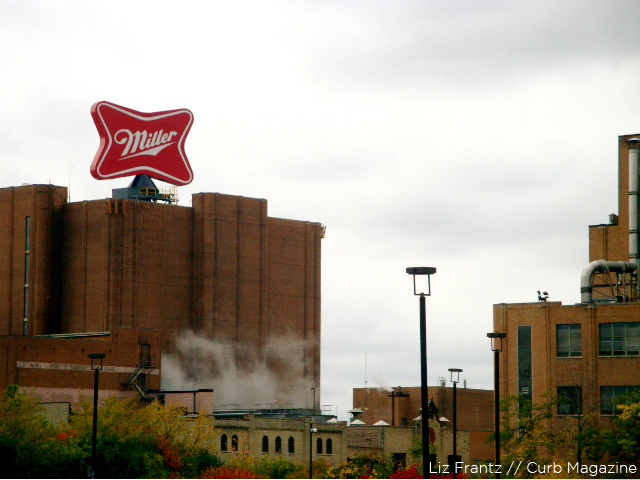
Miller's vintage beer label sign marks the brewery's location from the highway. Click photo for a gallery of Miller Brewery photos.
Next, our oddly silent group of 30 is off to the distribution center, a warehouse the size of five football fields holding half a million cases of beer. “The turnaround rate for this number of cases is one day,” Cavalier says, “so there will be all new cases in here tomorrow.”
The brewhouse is next. After about five flights of stairs, a row of copper brew kettles appears, ready to make Miller. Here we got the behind the scenes scoop on Miller beer production, beginning with the production of mash, the boiling of wort and the addition of hops. This is where the highway beer smell is born.
Every ounce of MillerCoors beer produced in Milwaukee comes from this very room, and today an aroma of barley, yeast, and a slight bitterness from the hops fills the observation area.
In fact, this yeast is part of what makes MillerCoors beer so spectacular. It’s not just normal yeast, but a specific prized lager strain which Frederick J. Miller hand-carried from Germany.
According to Green, the strain has been carefully nurtured and refined ever since, and is still used in many MillerCoors beers today.
The last stop before the highly anticipated free beer samples are Miller’s historic caves, created in the 1950s by Miller’s grandson Frederic C. Miller as a way to keep beer cool before the development of mechanical refrigeration.
They’re dark and chilly, exactly how you’d expect a cave to look, smell and feel. But the tour would not be complete without a cartoon Frederic J. Miller thanking us for visiting.
You’re welcome Frederick, now where’s the beer?
It’s in the Miller Inn, an authentic-looking tavern full of antique steins and other beer-related products from the 19th century. And the beer samples are not in Dixie cups, they’re in mugs – and there are refills.
Miller 64 is the most popular sample. The chilly, wholesome beer retains all the traditional Miller flavor of a full-calorie lager, except it has only 64 calories. The amber color is lighter of course, but it’s not bland.
Today, Miller is no longer Miller Brewing Company. They haven’t been just Miller since 2002 when South African Breweries bought them to form one of the largest breweries in the world, SABMiller, PLC.
In 2005, Miller celebrated its 150th anniversary, and in 2008, combined with Molson Coors to become a larger and more competitive player in the beer industry.
“Formerly, Miller had 18 percent of the beer market and Coors had 11 percent. By combining the two companies we now have 30 percent of the market share, which makes us more able to compete with Anheuser-Busch, that has nearly 50 percent,” Green says.
He also mentioned that merging the two companies creates substantial cost savings, which again allows MillerCoors to be more competitive in the beer market. “It also assures that we will be producing our beers farther into the future as one company than we could have as two,” he says.
Regardless of the company name, Miller and the existence of the Miller Brewery in Milwaukee have done a lot for the city and surrounding communities, whether they’re making a dragging Brewer game more fun or encouraging employment.
“We have a very large plant facility up here that employs nearly 900 people,” Green says. “We also have a great relationship with the city. There’s a mutual respect where Milwaukee supports MillerCoors and we support Milwaukee by getting behind a number of city initiatives.”
Ultimately though, it’s about the beer. And just like Kaminsky, Green would never touch a Budweiser.
“Would I ever drink that stuff? No.” he says. “As I told you, I believe that MillerCoors makes some of the best beers in the industry and certainly much better than Anheuser-Busch, so I wouldn’t think twice about who has the better beer. It’s clear that MillerCoors has the better product.”
Despite the price, Sweet proves his Miller loyalty every time he makes a beer run. “No matter how much money I have, I’ll always try to buy Miller,” he says. “I’m from Wisconsin, I should act like it.”
Pages: 1 2 < Previous




Discussion
No comments for “Miller Time”